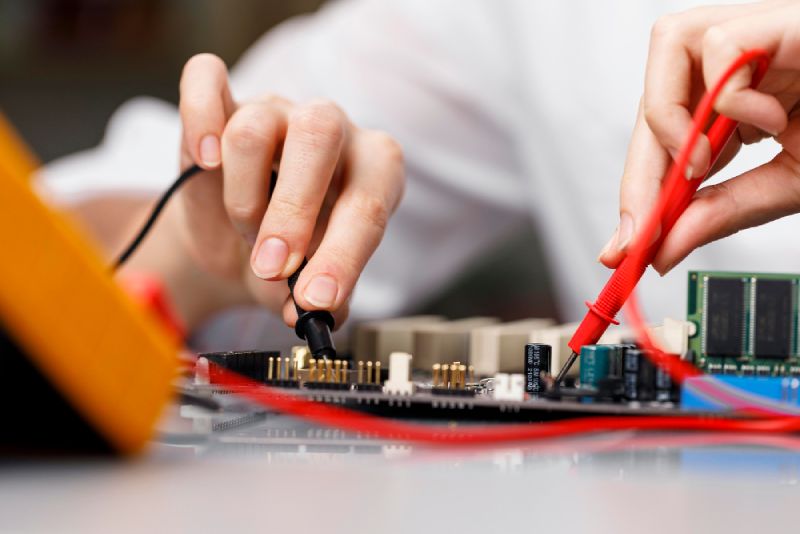What voltage is a motherboard PC?
Introduction
The motherboard is the central circuit board of a computer system, connecting and powering various components to ensure the smooth operation of the PC. One crucial aspect of the motherboard is its voltage requirements. Understanding the voltage specifications of a motherboard is essential for proper installation, operation, and maintenance of the computer system. In this article, we will delve into the topic of motherboard PC voltages, exploring the different voltage levels associated with various components and their significance.
Motherboard Voltage Basics
The motherboard requires different voltage levels to power its components effectively. The two primary voltage levels used in PC motherboards are +5V (5 volts) and +12V (12 volts). The +12V rail provides power to components such as the CPU and graphics card, while the +5V rail powers other components like RAM and USB devices.
The +12V Rail
The +12V rail is responsible for supplying power to the most power-hungry components in a PC, namely the CPU and graphics card. These components require a significant amount of power to function optimally. The +12V rail delivers stable and sufficient voltage to support the CPU’s processing capabilities and the demanding graphics processing required by modern games and applications.
Fun Fact: The +12V rail is often split into multiple rails on high-end motherboards to provide additional stability and prevent power overload.
The +5V Rail
The +5V rail powers several important components on the motherboard, including RAM modules, USB ports, and other peripheral devices. It is also responsible for powering the CMOS battery, which ensures that the motherboard retains BIOS settings even when the PC is turned off.
Voltage Regulation
To ensure the stability and reliability of the motherboard’s voltage supply, voltage regulators are employed. These regulators convert the power from the main power supply into the specific voltage levels required by the motherboard’s various components. Voltage regulation is important for maintaining the correct voltage levels, as fluctuations can lead to system instability, component failure, or even damage.
Table: Common Voltage Levels
| Component | Voltage Level |
|---|---|
| CPU | +12V |
| Graphics Card | +12V |
| RAM | +5V |
| USB Ports | +5V |
| CMOS Battery | +5V |
Does Motherboard Use 12V?
Introduction
A motherboard is the central component of a computer that connects various hardware components and allows them to communicate with each other. It provides power to these components through different voltage rails. One common question that arises is whether the motherboard uses 12V power.
Motherboard Power Connectors
The motherboard receives power from the power supply unit (PSU) through various connectors. The main power connector is the 24-pin ATX connector, which delivers multiple voltages including 12V, 5V, and 3.3V. This connector supplies power to the motherboard’s integrated circuits, expansion slots, and other components.
Additionally, the motherboard may also have additional power connectors, such as the 4-pin or 8-pin CPU power connector, which provides power specifically to the processor. This connector typically supplies 12V power to the CPU for stable operation.
Voltage Regulation
Once the power is supplied to the motherboard, it undergoes voltage regulation before being distributed to different components. Voltage regulators on the motherboard convert the incoming voltage to the specific voltages required by different components. These regulators ensure that each component receives the correct voltage for proper functioning.
Importance of 12V Power
The 12V power supply is crucial for the proper functioning of certain components in a computer system. It powers high-performance hardware like graphics cards, which often require significant amounts of power. Additionally, peripherals such as USB ports, fans, and cooling systems also utilize the 12V power supply.
Fun fact: Did you know that some high-end motherboards even feature additional 12V power connectors specifically designed for multi-GPU setups?
Is ATX 12V for CPU?
The ATX 12V specification refers to the power supply standard used in desktop computers. It provides a stable source of power to various components, including the CPU (Central Processing Unit). Let’s explore what ATX 12V is and its importance in powering the CPU.
What is ATX 12V?
ATX 12V is a power supply standard developed by Intel to provide reliable and efficient power to computer components. This specification defines the voltage outputs, connectors, and overall power delivery system of the power supply unit (PSU).
The PSU supplies power to multiple components in a computer system, such as the motherboard, graphics card, storage devices, and the CPU. It ensures that each component receives the required amount of power to operate optimally.
The Importance of ATX 12V for CPU
The CPU is the brain of a computer, responsible for executing instructions and performing calculations. As one of the most power-hungry components, it requires a stable and sufficient power supply to function correctly.
ATX 12V power supplies play a crucial role in delivering the necessary power to the CPU. They provide the required voltage levels and current capacities to ensure smooth operation and prevent potential damage caused by fluctuations in power.
Modern CPUs often require more power due to their increased performance capabilities. ATX 12V power supplies come in different wattage ratings to accommodate high-power CPUs, allowing users to choose a PSU that meets their specific needs.
ATX 12V Connectors for CPU
To connect the power supply to the CPU, ATX 12V power supplies typically feature a dedicated 4+4-pin or 8-pin connector. This connector provides both the standard 12V power and additional voltages required by the CPU.
The PSU’s 4+4-pin or 8-pin connector plugs into the corresponding socket on the motherboard, usually labeled “CPU_PWR” or similar. It ensures a secure and reliable power connection to the CPU.
Is CPU power 12V or 5V?
When it comes to powering a CPU, the voltage requirements vary depending on the specific processor and motherboard. However, in most modern desktop computers, the CPU power supply typically runs on 12V rather than 5V.
The Role of the CPU Power Supply
The CPU is the brain of the computer, responsible for executing instructions and performing calculations. To function properly, it requires a stable and reliable power source. The CPU power supply, also known as the CPU power connector, is responsible for delivering electrical power to the processor.
The CPU power supply is typically connected to the motherboard through a dedicated 4-pin or 8-pin connector. This connector provides the necessary voltage and current to the CPU, ensuring optimal performance and stability.
Understanding Voltage Differences
In electronics, voltage is the difference in electric potential between two points. Different components within a computer may require different voltage levels to operate. The 5V and 12V designations refer to the nominal voltages used in computer power supplies for various components.
While some older CPUs and motherboards may have used 5V for CPU power, this is not common in modern systems. The trend has shifted towards using 12V for CPU power, as higher voltages allow for increased power efficiency and reduced heat dissipation.
Power Requirements for CPUs
CPU power requirements vary depending on the specific model and generation. High-performance CPUs such as those used in gaming or professional applications generally require more power compared to entry-level or low-power CPUs.
To ensure compatibility and proper functioning, it is essential to check the CPU power requirements specified by the manufacturer. This information can usually be found in the CPU’s technical specifications or the motherboard’s documentation.
Is CPU Power 12V or 5V?
When it comes to computer hardware, one of the most common questions that arise is whether the CPU power is 12V or 5V. Understanding the voltage requirements of your CPU is crucial when choosing the right power supply and ensuring the stability and performance of your system.
Understanding CPU Power Voltage
The voltage required by a CPU depends on its architecture and generation. Generally, most CPUs used in desktop computers operate at a voltage of 12V, while some low-power CPUs found in laptops and mobile devices might require 5V. It is important to consult the specifications provided by the CPU manufacturer or check your motherboard’s documentation to determine the correct voltage requirement.
Power Supply Compatibility
When selecting a power supply for your computer, it is imperative to ensure that it provides the necessary voltage to support your CPU. Most modern power supplies are designed to accommodate both 12V and 5V requirements, making them compatible with a wide range of CPUs. However, it is always recommended to double-check the specifications of your power supply and ensure it meets the voltage requirements of your CPU.
The Importance of Voltage Stability
Regardless of whether your CPU requires 12V or 5V, maintaining a stable voltage is essential for optimal performance. Fluctuations or instability in voltage can result in system crashes, data loss, or even permanent damage to your hardware components. It is therefore crucial to invest in a reliable power supply that delivers a steady and consistent voltage output.
Conclusion
In conclusion, a motherboard does use 12V power to supply various components within a computer system. It receives power from the PSU through the main 24-pin ATX connector and may also have additional 12V power connectors for specific components like the CPU. Voltage regulators on the motherboard ensure that the appropriate voltage is supplied to each component for optimal performance.
In conclusion, ATX 12V power supplies are essential for powering the CPU in desktop computers. They provide the necessary stable power delivery to ensure optimal performance and prevent potential damage. The dedicated 4+4-pin or 8-pin connector on the power supply connects directly to the motherboard’s CPU socket to supply power to the CPU reliably.
When building or upgrading a computer system, it is crucial to choose a quality ATX 12V power supply that meets the power requirements of your particular CPU. This ensures a stable and efficient power supply, contributing to the overall performance and longevity of your computer.
In summary, the CPU power supply in modern desktop computers typically runs on 12V rather than 5V. Understanding the voltage requirements of your CPU is crucial for ensuring compatibility and optimal performance. Always refer to the manufacturer’s specifications to determine the appropriate power supply for your specific CPU and motherboard.
In conclusion, the voltage requirement for CPUs can vary depending on their architecture and generation. While desktop CPUs typically operate at 12V, low-power CPUs found in laptops and mobile devices may require 5V. It is important to consult the specifications provided by the CPU manufacturer or your motherboard’s documentation to determine the correct voltage requirement. Additionally, choosing a power supply that can provide the appropriate voltage and deliver stable power is crucial for maintaining the performance and longevity of your system.



